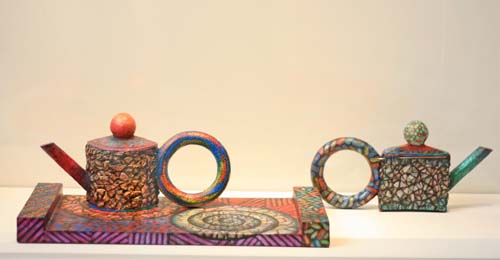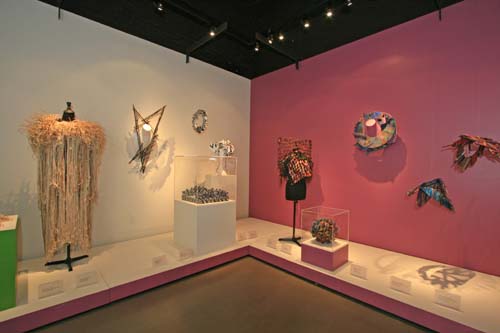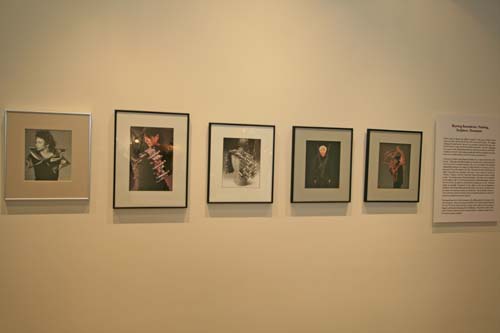

Sculpture Transformed: The Work of Marjorie Schick
June 29 - September 9, 2007
Exhibition courtesy of International Arts & Artists
For over four decades, Marjorie Schick has provoked delight and controversy with colorful, mixedmedia forms thatexplode the conventional limits of jewelry. Schick’s aim has always been to turn jewelry into a fine art. Resisting trends and theoretical fashions, she has cut her own path toward this goal, steadfasily exploring how a sculptural object and the body may entwine symbiotically, transforming the way both are understood. In the process, Schick melds ornament, painting, sculpture, and performanceart. Her objects appeal to a multi-sensory experience that as yet has no specific name.
Schick was born in Taylorville, Ilinois in 1941. She grew up in the Chicago area, studied for her M.FA. in jewelry and metalsmithing at Indiana University, Bloomington, and has served as a Professor of Art at Pittsburg State University, Pittsburg, Kansas, since 1967. Some see her roots in America’s heartland as the wellspring of her pioneering spirit. This independence enabled Schick to define an artistic vision that would resonate both at home and abroad.
Schick launched her career in the sixties, when artists onboth sides of the Atlantic were testing the limits of traditional forms and genres. The New Jewelry Movement took shape as jewelers cast aside conventions and innovated with materials and expressive possibilities. This offered Schick a perfect experimental environment shehad a conceptualfocus and inspirations drawn eclectically from tradifional ornament, from jewelers such as Margaret De Pata and Alma Eikerman, and from sculptors David Smith, Barbara Hepworth, Alexander Calder and others. By the eighties, Schicks daring forms secured her international reputation and a place in the Naw Jewelrycommunity among such peers as Wendy Ramshaw, Caroline Broadhead, and Arline Fisch.
Looking back, one also sees Schick’s work anticipating today’s art trends. Artists increasingly seek ways that their work may engage the body and senses. Nick Cave’s Soundsuits meld performance, identity transformation, and ornament. Sculptors such as Petah Coyne explore form and tacile appeal in non traditional sculptural materials. Others, like Laura Amussen and Toshiko Takaezu, create sculptural environments that cal tothe whole body. Schick engaged with such fundamental aesthetic issues from the beginning ofher career, grounded in the craftsperson’s commitment to handworking the propertiesof materials so they might serve her conceptual aims.
This is the first major retrospective of Mariorie Schick’s work. Her creations are consistently demanding and even controversial, requiring that we examine our assumptions about art forms and step willingly into a new kind of aesthetic experience. The rewards are great. Marjorie Schick never fails to surprise anddelight. Please enjoy the provocative universe of Sculpture Transformed.
Photos courtesy of Adam Willis.
PHOTO GALLERY
ABOUT THE ARTIST
For four decades Marjorie Schick has influenced the worlds of craft and jewelry both in the US and abroad. Though trained as a metalsmith and jeweler, Schick quickly acquired an international reputation for her sculptural experiments—made largely from alternative materials—that transcend traditional categories. Always conceived with the human form in mind, her challenging body sculptures are brilliantly colored mixed-media works that are simultaneously ornamental, performative, visual, and tactile.
Currently a professor at Pittsburgh State University in Kansas, Schick has pieces in many of the world’s major museums, including the Victoria and Albert Museum, London; Smithsonian’s Renwick Gallery, DC; Museum of Fine Arts, Boston; the National Museum of Contemporary Art, Seoul; Applied Art Museum, Oslo; and the Museum of Fine Arts, Houston, to name just a few. She has also been featured in Metalsmith, American Craft magazine, and International Crafts, and is the winner of several important awards, such as the Kansas Governor’s Arts Award and the NEW fellowship award in crafts.
Sculpture Transformed presented 67 objects that traced the 40 years of Schick’s experimentation with the body’s relation to form, texture, and color. The exhibition was curated by Tacey A. Rosolowski, PhD, a former Smithsonian Institution Fellow at the Renwick Gallery and an award-winning essayist and lecturer.
























